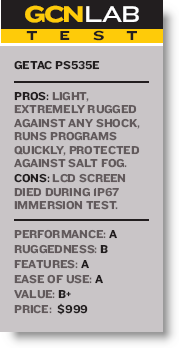GCN Lab Review: Getac PS535E


Connecting state and local government leaders
Many government workers need a computing device in the field, but might not necessarily need a full laptop computer. The Getac PS535E fills that bill nicely.
Land lubber: The PS535E PDA works great in almost all above-water conditions, but the unit quickly bubbled and died when submerged.
GCN
THERE ARE A LOT of government workers who need a computing
device in the field but might not necessarily need a full laptop
computer. In these cases, the weight savings from a rugged PDA
would be a welcome change. But the PDA has to be powerful and
rugged enough to survive intense outdoor conditions.
The Getac PS535E is up to the challenge. With a 400 MHz Samsung
S3C2440A processor and 64M of SDRAM, plus 2G of NAND Flash memory
for storage, it easily drives the Microsoft Windows Mobile 5.0
operating system without a hitch. Programs pop up quickly whether
you use the command buttons to run them or tap on the 3.5-inch LCD
screen.
The entire device only weighs 10.58 ounces and is 5.6 inches
long by 3.2 inches wide by 1.15 inches thick. Despite being small

enough to fit into the pocket of a Battle Dress Uniform or even the
pocket of a standard jacket, there are a lot of ports for
interfacing the PS535E with the world. It has one USB port, a
microphone jack, a line out port, a headphone jack and a spot to
connect an MMCX GPS Antenna.
In terms of being rugged, the PS535E is solid in most
atmospheric conditions. It survived every single drop, while
powered, as high as 48 inches without even a scratch and without
turning off. We think we could have probably taken the PS535E even
higher.
For those of you in the Navy or Marines, you probably want to
know that the PS535E is rugged against salt fog. We left the unit
powered inside our salt fog chamber for 48 hours, and it handled
the situation like a true sea dog.
Flushed with success, we decided to see if the Getac could
survive an IP67 immersion test with the PS535E. Even though this is
not listed in the product specs, an immersion test is displayed on
the company's Web site. The engineers called their Web video
an example of over-testing, but they said the unit would
survive.
We filled our fish bowl with water and powered the PS535E. We
lowered it in, and at first, everything was fine. Then it was like
the Titanic hitting an iceberg.
At first, there was just one little bubble to alert us to
trouble, coming out of an SD slot that was actually sealed and
screwed into the device. We had never touched that port, but
apparently it was not sealed properly. One bubble led to two, and
suddenly it was like someone pulled a cork out of a bottle. Water
rushed inside, and air rushed out in a torrent.
The LCD screen flickered for a moment and even seemed to get
brighter, then died. The whole thing took less than 10 seconds.
Although the LED lights above the screen continued to illuminate,
the PS535E was certainly dead, lying silently in its watery grave.
Thankfully this was the final test we had planned for the PS535E,
because it never came back.
If you keep the PS535E on land, you should be fine. It's a
great unit with a lot of power that won't weigh you down. But
until they improve the current design, you'll want to keep it
out of the water.
Getac, 949-699-2888, www.getac.com
NEXT STORY: GCN Lab Review: GD Itronix VR-2





